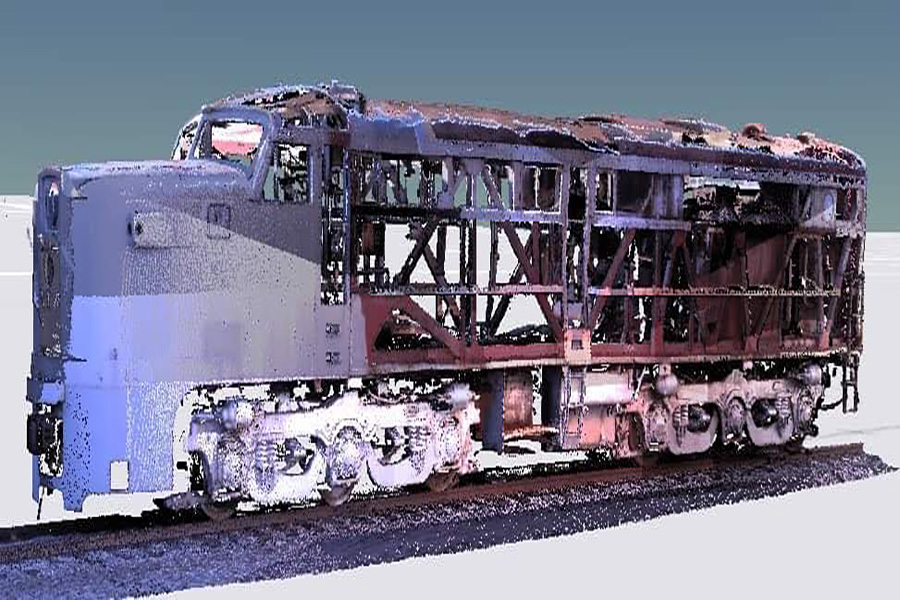TGS has had the unique opportunity to utilize their cutting edge laser scanning technology to build a 3-D model of an incredibly rare locomotive which will ultimately aid in it’s restoration.
EARLY HISTORY
The locomotive unit, Alco PA-1 #59L, is an early diesel passenger locomotive. It’s story began in 1948 and it was in service until it was derailed in 1981 in Mexico. When the derailment occurred the carbody was crushed. Nineteen years later in 2000 #59L and it’s running mate, #62 L were repatriated by the Smithsonian Institution through the persistence of William Withuhn and Doyle McCormack. Ultimately for the Smithsonian Institution the needs of their collection changed. Due to this change, #59L was housed in an Oregon railyard for nearly a decade. As this locomotive’s future was undetermined, the Museum of the American Railroad in Frisco, Texas expressed their interest in acquiring it. The Smithsonian generously donated #59L and the BNSF Railway committed to transport it to it’s new Texas home. As the carbody was damaged, it will now be restored with much care and attention to detail until in original condition. This unit’s carbody is very rare, there are only three others in the world that still exist today.
SCANNING ALCO PA-1 #59L
Due to the nature of the derailment the frame of the carbody and forward vertical posts still exist. This ensures that repairs will have accurate reference points to aid in the restoration. Rather than manually surveying each individual reference point Andy Nold and Garrett Smelker, surveyors at Transglobal, utilized the laser scanner to capture the necessary details. Due to the immense data that was collected in the scan, this has created a path to repair. Andy mentioned that his favorite part of working on the project was being out in the field which he thoroughly enjoyed. He also noted that seeing the detail that the scanner captures is fascinating as well.
3-D LASER SCANNER ADVANTAGE
The scanner utilizes a laser to capture millions of points a second which ultimately creates a necessary 3-D model for engineering projects. Utilizing a laser scanner for some specific projects ultimately saves our clients time and money, increases detail and data collected and ensures personnel safety.
When a scan is completed time and money are saved for the client as field days and expenses like mileage and per diem are reduced. This is due to the fact that the entire area can be scanned so if project needs change or any necessary data is not initially collected a crew does not have to be sent out multiple times. The 3-D scanner also collects data in much more detail than would be possible using traditional surveying methods. Furthermore, utilizing a laser scanner provides remote access to hazardous or restricted areas like railroad right of way, mines and intersections. It also allows facilities to stay in operation while the survey is being conducted. Utilizing a scanner in these situations ensures that the personnel conducting the survey are protected, which is a priority for Transglobal. Finally, all of the data is accessible in one place, so ultimately processing is automated.
A survey performed with a 3-D laser scanner would be the perfect option for a compressor station or to identify prefabricated walls during a build. In the past, Transglobal has even utilized laser scanning to map an entire waste water treatment plant, collecting 128.514 million points in just one day. Employing this cutting edge technology to provide a high quality end product to our clients is something Transglobal is and will always be passionate about.
INVESTING IN OUR COMMUNITIES
Transglobal is also committed to investing back into the community, which is why this partnership with the Museum of the American Railroad was such a special opportunity for both parties. Robert Willis, Trustee at the Museum of the American Railroad shares “Although this is a great honor and opportunity to publicly display this ultra rare survivor, there are significant challenges in effecting repairs because of the damage. This is where businesses like Transglobal can be of great assistance by providing pro bono technical assistance to help ensure that the best possible restoration is completed.” Watching the Alco PA-1 locomotive #59L begin and eventually complete restoration is an exciting endeavor for all involved.
To learn more about the status of the project and the museum itself, visit www.museumoftheamericanrailroad.org.


